
Washington, D.C.-area residents gather to take the water taste test challenge. Photo courtesy of the DC Water Office of External Affairs.
DC Water (Washington, D.C.) has been working to spread the message that tap water tastes great and offers a cheaper, more environmentally friendly alternative to Washington, D.C.-area residents. The utility has been hosting taste test challenges and partnering with the organization TapIt (New York) on various outreach efforts including the recent release of a tap-water locator app, according to Nicole Condon, water communications coordinator for DC Water.
Throughout the summer of 2013, DC Water conducted its second annual citywide taste test challenge. Setting up outside grocery stores, public-transit stations, and other high foot-traffic areas, DC Water representatives equipped with giveaways to attract participants, asked locals to taste from two cups of ice-cold water and see if they could tell the difference between tap and bottled water. To make sure the test was fair, employees even made ice from the bottled water, Condon said.

Challenge participants were asked to see if they could tell the difference between tap and bottled water. Photo courtesy of the DC Water Office of External Affairs.
“Hands-on interaction and face-time with our customers gives us a really great opportunity to connect with them, whether it’s answering questions or offering resources,” Condon said.
After 557 locals participated in the challenge, 264 preferred tap water and 86 could not tell the difference, amounting to about 63% of residents who either preferred tap or could not tell the difference, Condon said. And after 840 locals participated in the 2012 challenge, this number was about 60%, she added.
“People actually really do like the taste of our product, and it’s a fraction of the cost and it’s much more environmentally friendly,” Condon said. “If we can get enough people to learn just those few things about our product, we can continue growing our customer confidence and to continue to promote the product,” she said.

Of the 557 participants, 63% either preferred tap or could not tell the difference between tap and bottled water. Photo courtesy DC Water Office of External Affairs.
The unique outreach effort has the added benefits of engaging residents, allowing the utility to determine topics to focus on with future communications and education efforts, and providing an opportunity to educate about the entire treatment process.
“It’s an opportunity for us to talk about the entire cycle,” Condon said. At the challenges, they talk to participants about how DC Water not only provides drinking water, but also is one of the largest water resource recovery facilities in the world. They also talk about water quality standards DC Water has to meet both for drinking and treated effluent, infrastructure projects that are occurring, reasons to choose tap over bottled water, and household water quality tips.
At the challenges, DC Water representatives explain that bottled water is about 1000 times more expensive than tap and does not have to meet the same water-quality standards, she added. And that only 25% of plastic water bottles are recycled, resulting in a majority of the bottled water consumed contributing to wastestreams, Condon said. In addition, drinking cold water ensures consumption of the highest quality of water because it comes straight from the distribution system instead of waiting in hot water heaters. They also share a tip that by putting tap water in a pitcher in the refrigerator, some chlorine will off-gas, further improving the taste of tap water, she added.

DC Water uses the challenge as an ongoing opportunity to educate residents about the benefits of tap water and clean water efforts by the organization. Photo courtesy of the DC Water Office of External Affairs.
“It’s a really great opportunity to do some informal data gathering,” Condon said. By starting a conversation with customers, DC Water discovered that many still boil their water before drinking it. In response the utility developed an educational bill stuffer to “debunk” the “long-standing myths,” she added. Customers need to know when and why they need to boil water and that doing so on a regular basis does nothing, she explained.
In addition, in 2011, the TapIt program launched in Washington, D.C., and DC Water signed on as a partner to promote the program. In September, area partners launched a mobile app that locals can use to find locations to refill water bottles with tap water. The TapIt Metro D.C. app provides information on where and how to fill up water bottles as well as the ability to share on social media that you used the service. DC Water worked with other area partners to get businesses and organizations to participate and load information into the app, Condon said.
Feedback from the campaigns has been positive and DC Water plans to continue working to educate their customers. “It reinforces our overall drink tap campaign that’s an ongoing effort,” Condon said.
The utility plans to work on providing incentives for more businesses to participate in the TapIt program and to conduct both citywide and smaller-scale taste test challenges in the future, Condon added.
— Jennifer Fulcher, WEF Highlights








January 8, 2014
Featured